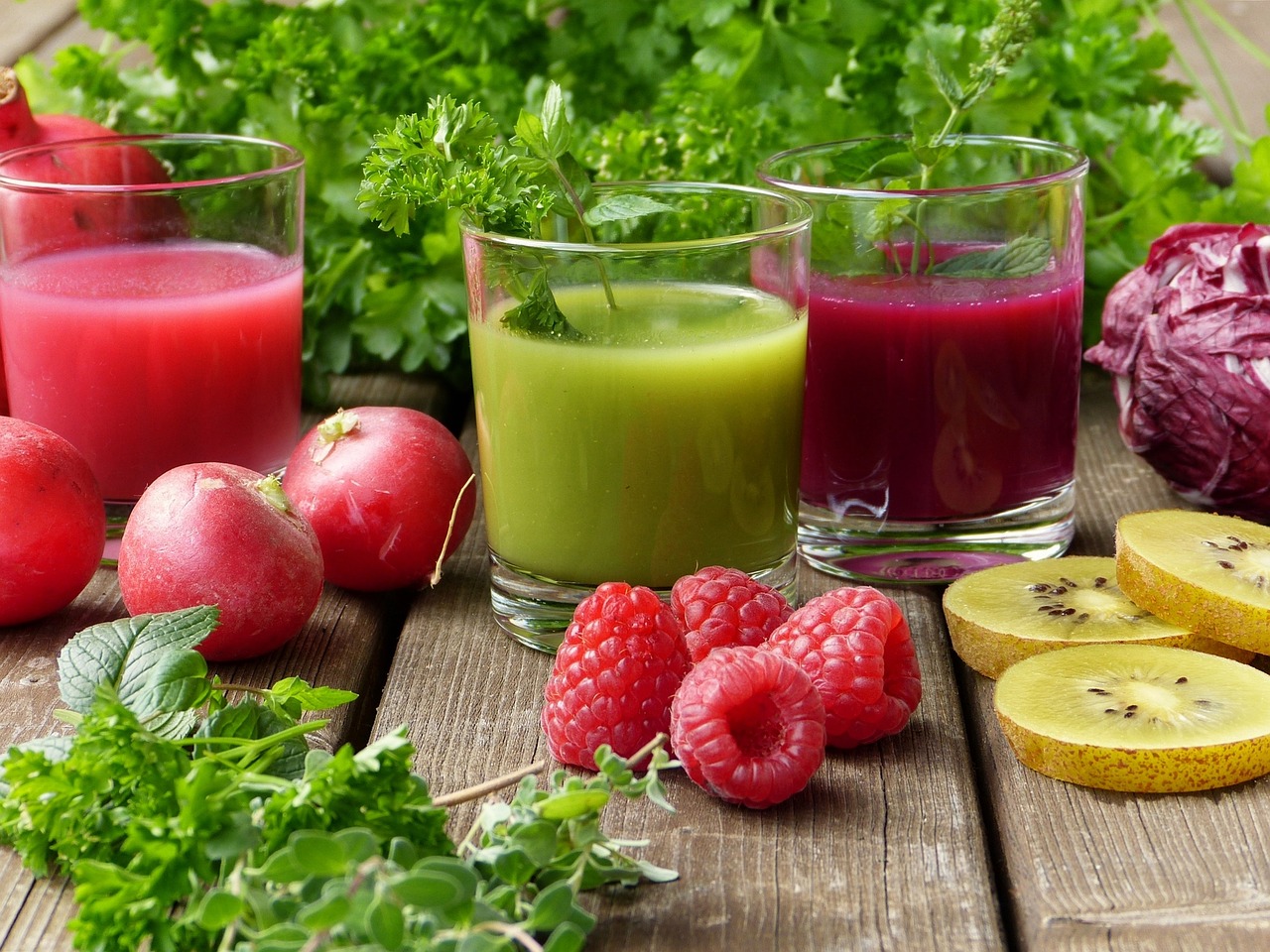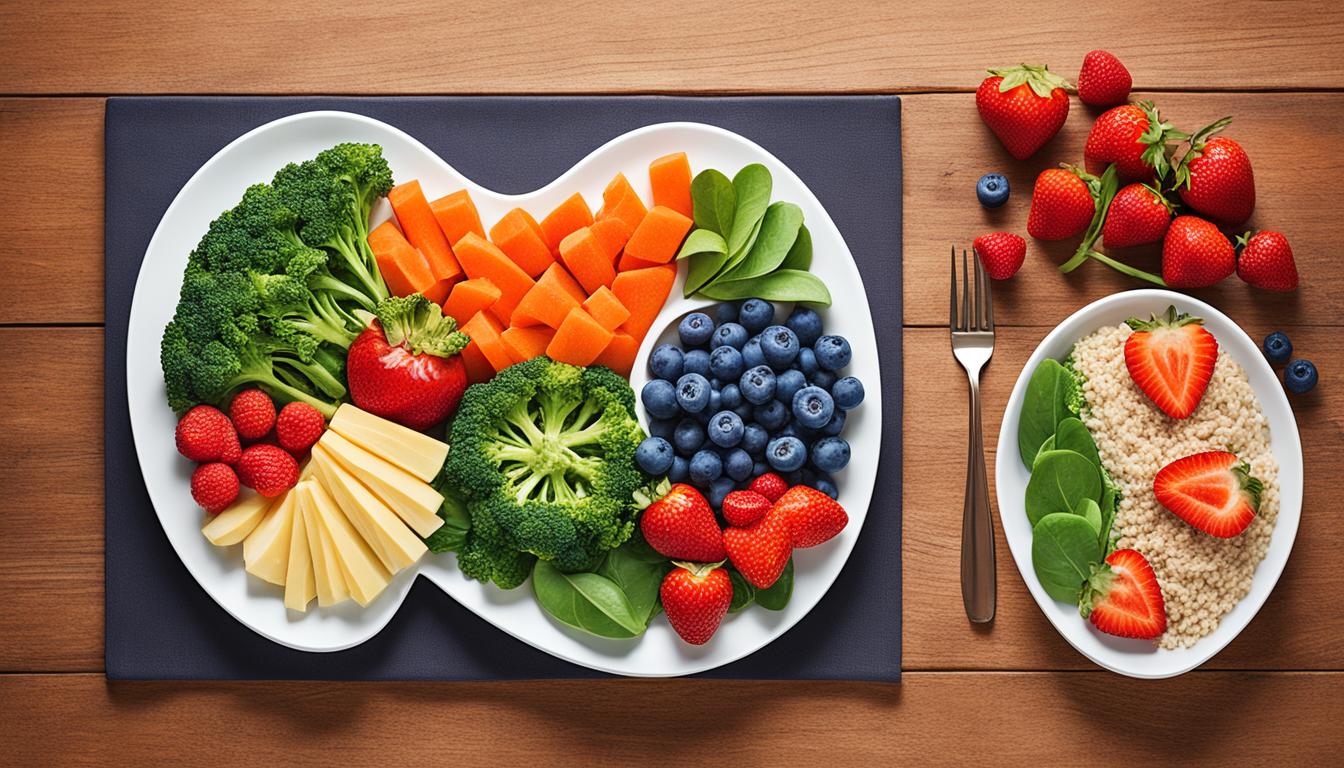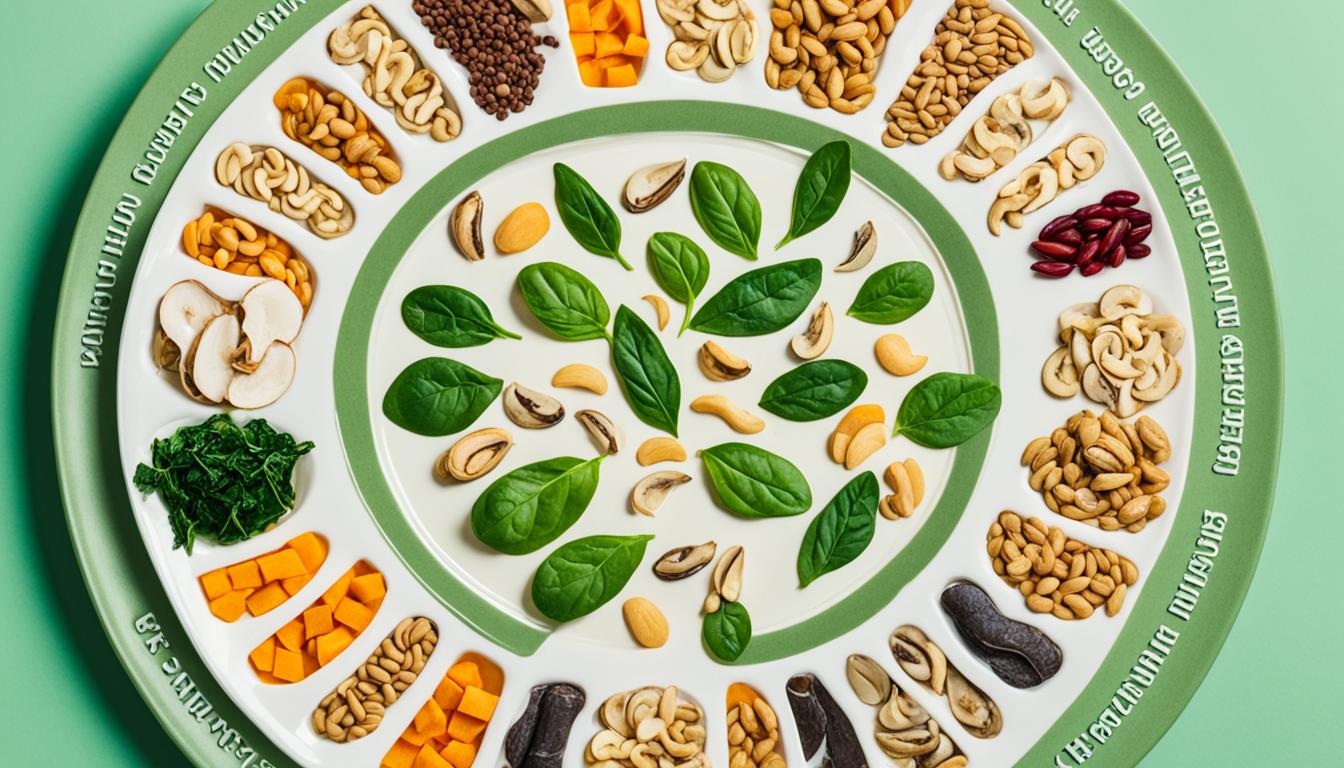Dangers of Ultraprocessed Foods

Have you ever wondered about the true impact of those irresistible cookies, chips, and frozen meals you can’t seem to resist?
What if I told you that these ultraprocessed foods, cleverly designed to satisfy your cravings, could be wreaking havoc on your health?
In a world of convenience and fast-paced lifestyles, ultraprocessed foods have become all too common. But it’s time to shed light on the hidden dangers lurking behind those enticing packages.
Join us as we delve into the world of ultraprocessed foods, uncovering the shocking truth about their impact on our health and well-being.
Key Takeaways:
- Regular consumption of ultraprocessed foods increases the risk of cardiovascular disease, certain cancers, obesity, and type 2 diabetes.
- Ultraprocessed foods are industrial creations made with little-to-no whole foods and often contain high levels of added sugar, salt, and artificial additives.
- The extreme palatability of ultraprocessed foods, due to a combination of fat, sugar, and salt, makes them difficult to resist and can lead to overconsumption.
- Ultraprocessed foods have been associated with changes in the gut microbiome, which can impact overall health, including mental well-being.
- To make healthier choices, focus on whole foods, home-cooked meals, and minimizing the consumption of ultraprocessed foods.
Types of Food Processing
Food processing plays a significant role in shaping the nutritional value and overall composition of the foods we consume. The degree of processing can range from minimal to extensive, resulting in a wide variety of different food products available on the market.
Unprocessed and minimally processed foods:
Unprocessed or minimally processed foods are those that have undergone little to no alteration from their natural state. These foods include fresh vegetables, fruits, meats, eggs, and dairy products. They retain their original nutritional properties and are free from any artificial additives or preservatives.
Processed Culinary Ingredients:
Processed culinary ingredients are substances that are typically added to recipes for flavor, texture, or preservation purposes. These ingredients, such as oils, butter, sugar, and salt, are rarely consumed on their own but play vital roles in cooking and baking.
Processed Foods:
Processed foods are foods that have undergone some degree of processing, usually combining both unprocessed and minimally processed ingredients. Examples of processed foods include homemade bread, canned vegetables, and roasted nuts. While they may contain some additives for flavor or preservation, they generally retain a significant amount of their natural nutritional content.
Ultraprocessed Foods:
Ultraprocessed foods undergo extensive industrial processing and are made with heavily modified raw ingredients and various additives. These foods often include popular convenience items like cookies, chips, frozen meals, and fast food. Ultraprocessed foods typically have high levels of added sugar, fat, and/or salt, making them less nutritious compared to unprocessed or minimally processed options.
Understanding the different types of food processing helps us make informed decisions about the foods we consume. It allows us to choose whole and minimally processed options that retain their nutritional value while minimizing the consumption of heavily processed and ultraprocessed foods.
Understanding Ultraprocessed Foods
Ultraprocessed foods are a distinct category of foods that go beyond what can be created in an ordinary kitchen. These foods contain ingredients that are typically not found in homes and undergo industrial processes that are difficult to replicate. They are often loaded with additives that serve various purposes, such as enhancing flavors, binding ingredients together, and increasing shelf life.
Researchers commonly use the NOVA classification system to categorize foods based on their degree of processing. This system helps identify and classify ultraprocessed foods, providing a comprehensive understanding of their impact on health. Ultra-processed foods are characterized by a long list of ingredients, many of which are not commonly used in home cooking. Even though some ultraprocessed foods may be fortified with nutrients, they are still considered ultraprocessed due to their artificial nature and lack of whole, natural ingredients.
Some scientists propose that specific additives, flavors, emulsifiers, and other ingredients can be key indicators of ultraprocessed foods.
The extreme palatability of ultraprocessed foods is a result of careful formulation, often combining high levels of fat, sugar, and salt. This combination makes these foods highly enjoyable, leading to overconsumption and potential negative health effects.
NOVA Classification System
| NOVA Category | Description |
|---|---|
| Unprocessed or minimally processed foods | Foods in their natural state or with minimal alterations, such as fresh fruits, vegetables, and eggs |
| Processed culinary ingredients | Ingredients used in cooking but not typically consumed alone, such as oils, butter, and sugar |
| Processed foods | Foods made from unprocessed or minimally processed ingredients, like homemade bread |
| Ultraprocessed foods | Industrially modified foods with a long list of ingredients, often high in added sugar, fat, and/or salt |
Table: NOVA Classification System
Understanding the nature and characteristics of ultraprocessed foods is essential for making informed dietary choices. By prioritizing whole, unprocessed, or minimally processed foods, individuals can improve their nutrient intake and overall health.
Health Risks with Ultraprocessed Foods:
Research studies have identified several health risks associated with the higher consumption of ultraprocessed foods. While a direct causal link has not been established, there is evidence to suggest that these foods have negative effects on overall health and well-being.
One of the most significant health risks is obesity. Ultraprocessed foods are often high in added sugars, unhealthy fats, and calories, making them a contributing factor to weight gain and obesity.
In addition to obesity, the consumption of ultraprocessed foods has been linked to an increased risk of type 2 diabetes. These foods tend to be low in fiber, vitamins, and minerals and high in refined carbohydrates, which can lead to impaired glucose control and insulin resistance.
Cardiovascular disease:
is another concern associated with ultraprocessed food intake. These foods are typically high in sodium, unhealthy fats, and added sugars, which can contribute to high blood pressure, elevated cholesterol levels, and an increased risk of heart disease.
Studies have also found a potential connection between ultraprocessed foods and certain types of cancer. The consumption of these foods, coupled with their low nutrient density and potential exposure to harmful chemicals and additives, may contribute to an increased risk of developing certain cancers.
The gut microbiome, which consists of trillions of microbes in the digestive tract, plays a crucial role in overall health. Preliminary research suggests that ultraprocessed foods can negatively impact the diversity and composition of the gut microbiome, leading to potential gut dysbiosis and associated health consequences.
Mental health is another area where ultraprocessed foods may have an impact. While further research is needed, some studies have found an association between the high consumption of ultraprocessed foods and increased risks of depression and anxiety.
The absence of fiber in ultraprocessed foods is concerning. Fiber is essential for maintaining healthy digestion, regulating blood sugar levels, and supporting overall gut health. The lack of fiber in these foods can lead to increased hunger, disturbed energy balance, and potential negative effects on gut health.
It is essential to note that making healthier dietary choices, focusing on whole and minimally processed foods, can help mitigate these health risks associated with the consumption of ultraprocessed foods. Prioritizing a diet rich in fiber, vitamins, and minerals from natural food sources can have a positive impact on overall health and well-being.
Key Takeaways:
- Consuming ultraprocessed foods is associated with a higher risk of obesity, type 2 diabetes, cardiovascular disease, and certain cancers.
- Ultraprocessed foods may negatively impact the gut microbiome and mental health.
- The absence of fiber in ultraprocessed foods can lead to increased hunger and disturbed energy balance.
- Making healthier dietary choices by focusing on whole foods and minimizing ultraprocessed foods is crucial for mitigating these health risks.
Identifying Ultraprocessed Foods
Nutrition labels are a valuable tool for identifying ultraprocessed foods. These foods typically have a long list of ingredients that are not commonly used in home cooking. If you don’t recognize many of the ingredients listed, it could be a sign of extensive processing.
Here are some key factors to consider when identifying ultraprocessed foods:
- Read the nutrition labels: Pay attention to the ingredients listed. Look for unfamiliar or chemical-sounding names, as these can indicate highly processed foods.
- Evaluate processing methods: Investigate how the food is processed. Methods like hydrogenation and hydrolysis, which involve extensive industrial processes, are common in ultraprocessed foods.
- Watch out for added fat and sugar. Ultraprocessed foods often contain high amounts of added fat and sugar, making them calorie-dense compared to most whole foods.
It’s important to note that not all calories are created equal. Some foods that are marketed as healthy can still be highly processed. By examining the nutrition labels, you can make more informed choices about the quality of the food you consume.
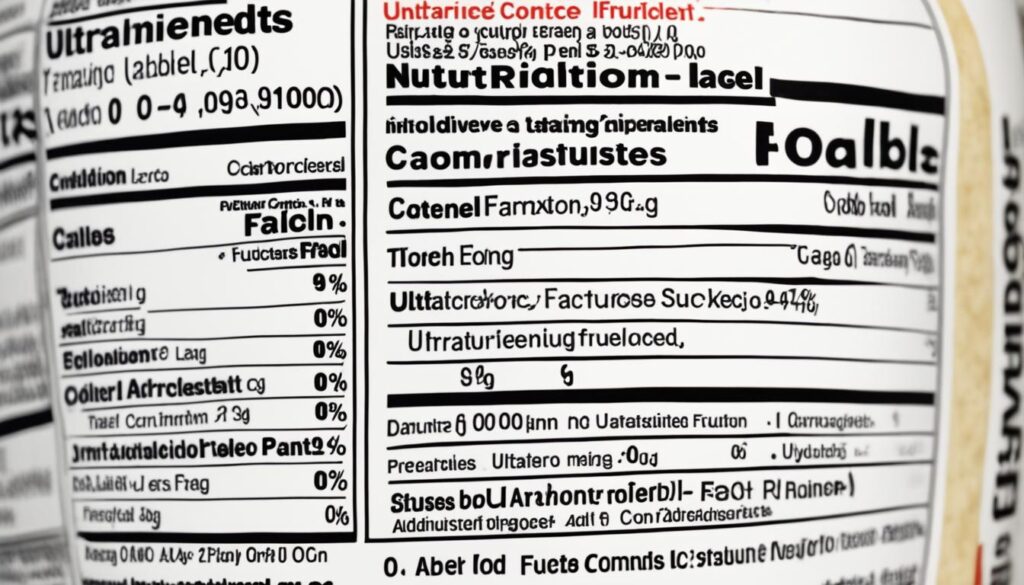
| Nutrient | Amount per serving |
|---|---|
| Calories | 230 |
| Total Fat | 14g |
| Saturated Fat | 6g |
| Total Carbohydrate | 22g |
| Sugar | 12g |
| Protein | 4g |
| Sodium | 300mg |
This nutrition label example showcases the caloric value, fat, carbohydrates, sugar, protein, and sodium content of an ultraprocessed food. By analyzing the information provided, consumers can make more informed decisions about their dietary choices.
“Reading the nutrition label on food products is an essential step towards understanding the processing methods and ingredients used. Don’t be fooled by marketing claims; always trust the facts on the label!”
Making Healthier Choices
When it comes to improving your diet and overall health, opting for whole foods and home-cooked meals is essential. Whole foods, such as fresh fruits and vegetables, provide a higher nutritional value compared to ultraprocessed foods that are often loaded with additives. By cooking meals using fresh ingredients and minimizing the use of packaged and processed foods, you can prioritize your well-being.
Frozen vegetables are a convenient alternative to fresh produce, as they retain their nutrients and can be easily incorporated into various dishes. Canned beans and canned fish are also practical options that offer nutritional benefits, such as protein and omega-3 fatty acids. These pantry staples can be used to create quick and nutritious meals.
When grocery shopping, focus on shopping the perimeter of the store, where fresh produce is typically located. This allows you to maximize your intake of whole foods and minimize exposure to highly processed items that often line the store’s aisles. By opting for foods without labels or those with fewer added ingredients, you can make healthier choices and reduce your consumption of ultraprocessed products.
To provide a visual comparison, here’s a table highlighting the benefits of whole foods versus ultraprocessed foods:
| Whole Foods | Ultraprocessed Foods |
|---|---|
| Higher nutritional value | Lower nutritional value |
| Fewer additives and preservatives | High levels of added sugar, fat, and salt |
| Supports overall health and well-being | Increase the risk of various health complications |
Remember, making healthier choices doesn’t mean completely eliminating all processed foods from your diet. It’s about finding a balance and prioritizing whole, unprocessed foods whenever possible. By incorporating more whole foods and home-cooked meals into your daily routine, you’ll be on your way to a healthier lifestyle.
A personalized approach to Healthy Eating
When it comes to creating a healthy eating plan, it’s important to take individual preferences and needs into account. Making small changes that are both sustainable and aligned with your personal preferences is key to long-term success. But where do you start?
Consulting with a doctor or healthcare professional can provide valuable guidance tailored to your specific health needs. They can help you identify areas for improvement and recommend lifestyle changes that will have the greatest impact on your well-being. Remember, everyone’s journey is unique, and your healthcare provider can offer personalized advice to ensure you’re on the right path.
One effective approach is to focus on establishing one healthy habit at a time. By taking small steps and gradually integrating new behaviors into your daily routine, you’ll find it easier to maintain a healthy lifestyle. For example, start by incorporating more fruits and vegetables into your meals, then build upon that success by exploring new recipes and experimenting with different flavors.
It’s important to find a balance that works for your individual lifestyle and preferences. The best diet is the one you can follow consistently. So, take the time to explore different foods, flavors, and cooking methods to discover what works best for you. Embrace variety and be open to trying new things. so you might be surprised by the delicious and nutritious options available to you.
Nutritionist’s Tip:
“When making changes to your diet, remember that small steps can lead to significant results. Don’t overwhelm yourself with drastic changes all at once. Instead, focus on making one positive change at a time. Celebrate your progress and build upon it for long-term success.”
By embracing a personalized approach to healthy eating, you can create a sustainable and enjoyable way of nourishing your body. Stay true to your individual preferences, seek guidance from healthcare professionals, and make small changes that align with your lifestyle. Remember, every small step counts on your journey to better health.
| Benefits of a Personalized Approach | Tips for Success |
|---|---|
|
|
The Importance of Goal Setting
When it comes to making sustainable changes to your dietary habits, setting goals is crucial. By identifying small steps that can be taken, you can gradually reduce the consumption of ultraprocessed and processed foods, making way for healthier choices. Working with a doctor or healthcare team can help you develop specific and actionable goals tailored to your unique needs and circumstances.
Setting achievable goals is essential for long-term success. Start by focusing on one habit change at a time, such as replacing a sugary snack with a piece of fresh fruit or drinking more water instead of sugary beverages. These small changes can add up over time and have a significant impact on your overall health.
“Setting goals is not about perfection; it’s about progress.”
With each goal you achieve, it becomes easier to make additional changes. Celebrate your accomplishments and use them as motivation to keep going. Remember, sustainable changes take time, so be patient with yourself and don’t get discouraged if you experience setbacks along the way.
By setting goals and making gradual changes to your dietary habits, you can establish healthier routines that are easier to maintain in the long run. Whether it’s incorporating more whole foods into your meals, cooking at home more often, or reducing your intake of processed foods, every step forward is a step towards better health.
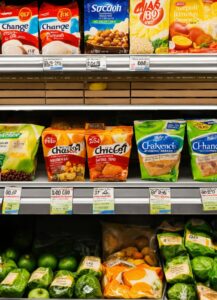
Benefits of Goal-Setting
Goal setting provides a clear vision and direction, helping you stay focused on your journey to healthier eating habits. Here are some key benefits:
- Increased motivation and commitment
- Improved self-discipline
- Enhanced accountability
- Greater self-awareness
- Measurable progress and milestones
Creating SMART Goals
When setting goals, it’s important to make them SMART: specific, measurable, achievable, relevant, and time-bound. Here’s an example:
- Specific: Instead of a vague goal like “eat healthier,” specify a behavior change such as “eat five servings of fruits and vegetables daily.”
- Measurable: Use quantities or measurements to track your progress. In this example, the measurable component is “five servings.”
- Achievable: Set realistic goals that you can feasibly achieve. Gradually increasing your fruit and vegetable intake is attainable for most individuals.
- Relevant: Ensure your goals align with your overall objective of healthier eating habits.
- Time-bound: Add a deadline to create a sense of urgency and prioritize your efforts. For instance, set a goal to achieve the desired daily servings within a month.
Remember, your goals should be tailored to your own needs and preferences. Consult with a healthcare professional to develop goals that are suitable for you.
By setting achievable goals and approaching them with a positive mindset, you can make sustainable changes to your dietary habits and improve your overall well-being.
so,The dangers of consuming ultraprocessed foods on health are well-documented. These foods increase the risk of various health complications, including cardiovascular disease, type 2 diabetes, obesity, and certain cancers. To make healthier dietary choices, it is crucial to opt for minimally processed and whole foods.
Being aware of the processing methods and ingredients used in food products is essential. Reading nutrition labels can provide valuable information about the nutritional value and additives present in a product. By cooking meals at home using fresh ingredients whenever possible and prioritizing a diet rich in fruits, vegetables, and unprocessed or minimally processed foods, individuals can take important steps toward improving their overall health and well-being.
Adopting personalized approaches to healthy eating and setting achievable goals can lead to sustainable changes in dietary habits. By making small changes over time and working with healthcare professionals, individuals can navigate their dietary choices in a way that aligns with their specific needs and preferences. It is through these intentional choices that individuals can ultimately enhance their health and maintain a balanced and nutritious lifestyle.
FAQ
What are the dangers of consuming ultraprocessed foods for health?
What are the different types of food processing?
How do I identify ultraprocessed foods?
What health risks are associated with ultraprocessed foods?
How can I identify ultraprocessed foods?
How can I make healthier food choices?
Is there a personalized approach to healthy eating?
How important is goal-setting in making dietary changes?
What should I keep in mind about ultraprocessed foods and healthy eating?





